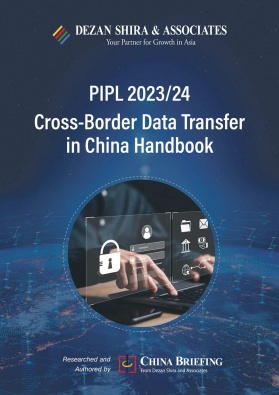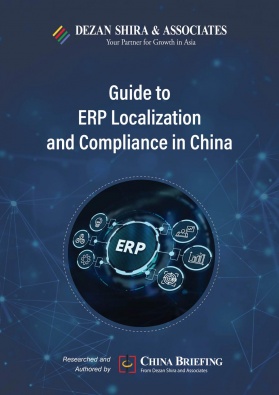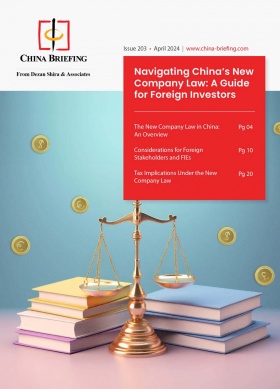China’s New Tariff Law: Consolidating and Codifying Existing Tariff Regulations
China’s new Tariff Law consolidates rules on import and export duties that were previously implemented via several legal documents and makes important clarifications and additions to prior regulations. Among other changes, it stipulates provisions for the Chinese government to impose counter-tariffs on imported goods, codifying these powers into law for the first time. We outline all the notable updates to the China Tariff Law and discuss the implications for the country’ current trade relations.
On April 26, 2024, the National People’s Congress (NPC), China’s legislature, adopted the Tariff Law of the People’s Republic of China (the “Tariff Law”) after several rounds of revisions.
The new Tariff Law will replace the Import and Export Tariff Regulations of the People’s Republic of China, which fall under the purview of the State Council, and adopts many of its provisions.
Notably, the Tariff Law is not a simple upgrade of the content in the Import and Export Tariff Regulations. Instead, it explicitly clarifies the content related to tariff collection that is currently scattered across various measures and announcements and organizes it into legal provisions. For example, the new Tariff Law importantly codifies the means for the Chinese government to impose anti-dumping and countervailing duties on trade partners.
Previously, Chinese law had not stipulated legislative powers to implement countervailing tariffs, although China was nonetheless able to impose counter-tariffs on trade partners through other means.
China’s new Tariff Law comes into effect on December 1, 2024.
Noteworthy changes in the Tariff Law
China’s Tariff Law elevates several existing provisions and practices to the level of law. For instance, Article 3 of the Tariff Law clarifies the obligations of cross-border e-commerce platforms for tariff withholding and implementing consolidated taxation.
The Tariff Law also solidifies the rules and regulations on the origin of goods, stipulating that the application of tariff rates shall comply with the corresponding rules of origin. Although this has been previously implemented in practice, it is the first time this has been codified into law.
Customs authorities are now also explicitly empowered to confirm the amount of tax payable within three years from the date of payment or release of goods by taxpayers or withholding agents. This limitation does not apply to smuggling offenses.
Other major changes to the tariff regulations in the Tariff Law include:
- The deadline for taxpayers to apply for the refund of overpaid taxes has been extended to three years, up from one year.
- Force majeure has been added as a circumstance in which the re-export or re-import of goods is exempt from customs duties. Previously, only goods that were re-exported or re-imported “due to quality or specification reasons” could be exempt from customs duties, which could be difficult to prove for traders. The addition of a force majeure will allow traders who need to re-import or re-export due to reasons, such as sudden changes in overseas trade policies, market conditions, or suspension of shipments, to be exempt from customs duties (re-exports of goods in their original condition can be exempt from export duties for up to one year from the date they were initially imported).
- Measures have been introduced to address taxpayers’ outstanding tax liabilities, including allowing customs to notify immigration authorities to impose exit restrictions on taxpayers or their legal representatives in accordance with regulations.
- In cases where actions result in a reduction of taxable amounts without a reasonable commercial purpose, the tax authorities can now take anti-avoidance measures by adjusting tariffs.
- Three new administrative penalty rules have been added, including a penalty of between 50 percent and three times the amount of tax due for withholding obligors who fail to withhold or collect taxes due.
Provisions on anti-dumping and countervailing duties in the Tariff Law
Under the Tariff Law, a Tariff Commission under the State Council will have the power to “decide to levy anti-dumping duties, countervailing duties, safeguard measures tariffs, and implement other tariff measures decided by the State Council” (Item 6, Article 7).
Besides, the Tariff Commission will have the power to propose “corresponding measures based on the principle of reciprocity” if a country or region doesn’t fulfill the most-favored-nation (MFN) treatment or preferential tariff treatment stipulated in international tax treaties to which China is a party.
In addition, if a country or region adopts trade prohibitions, restrictions, tariffs, or other measures that affect normal trade against China in violation of international treaties or agreements to which China is a party, China can implement measures such as retaliatory tariffs against imported goods originating from this country or region.
The Tariff Commission will be responsible for implementing the scope of goods subject to retaliatory tariffs, the applicable countries or regions, tax rates, deadlines, and collection methods after approval by the State Council.
If a taxpayer fails to furnish the required supporting documentation for imported goods subject to countervailing tariffs, or if the provided documentation fails to sufficiently prove, after customs review, the origin of the goods from the country or region subject to specified measures, such goods will be subject to the prevailing tax rate. This rate may encompass taxes applicable under relevant international tax treaties, preferential policies, special tariffs, or the standard tax rate, whichever is higher.
The implications of the new counter-tariff provisions
The new provisions on counter-tariff measures in the Tariff Law provide a legal basis for China to impose tariffs on goods that have themselves placed tariffs on Chinese goods. This is in some regards a technical change only, as China has already been able to impose counter-tariffs on trade partners in the past.
In 2018, following the Trump Administration’s imposition of sweeping tariffs targeting a variety of Chinese goods, China imposed counter-tariffs on US goods, targeting in particular agricultural products. In 2020, China also imposed anti-dumping duties on some Australian goods, including barley and wine.
However, the Tariff Law does send a clear signal to trade partners that China will be able and willing to impose counter-tariffs should they implement import duties on Chinese goods and reflects the changing dynamics of global trade amid heightened geopolitical tensions. The new law also comes at a time when multiple regions are threatening to impose additional tariffs on Chinese goods.
The most obvious potential target of these new provisions is the US, which continues to impose Trump-era Section 301 tariffs on over US$500 billion worth of Chinese goods. In October 2023, the Biden Administration also implemented export controls on key semiconductor technology to China, and as recently as April 2024, called for tripling tariffs on Chinese steel and aluminum imports.
China has also continued to impose tariffs on US goods, most recently in April when the Ministry of Commerce imposed a 43.5 percent anti-dumping tariff on US propionic acid imports.
On the other side of the Atlantic, the EU has also been increasing rhetoric on China’s alleged unfair trade practices and making moves to implement anti-dumping duties on some Chinese goods. In October 2023, the EU launched an anti-subsidy probe into Chinese EV exports, which could result in the imposition of countervailing tariffs. It has also stated it plans to launch a similar probe into Chinese steel products. In November, the EU began imposing provisional anti-dumping duties ranging from 6.6 percent to 24.2 percent on imports of certain polyethylene terephthalate (PET) plastic products from China.
With China’s Tariff Law in place in December, it is highly likely that any further moves by the US or the EU to impose anti-dumping or countervailing tariffs on Chinese imports will result in retaliatory duties placed on goods of US and EU origin. It is nonetheless unlikely that this will deter the US or the EU from continuing with current plans; instead, diplomatic dialogue and cooperation will be a more likely path to avoiding the escalation of trade tensions.
Background: Establishing law-based tax administration
In 2015, the State Tax Administration (STA) released the Guiding Opinions on Comprehensively Promoting the Governing of Taxes according to Law (Shui Zong Fa [2015] No.32), stipulating that China will accelerate the process of upgrading relevant tax regulations into law, to improve the certainty of tax policies, enhance the authority of the tax documents, and improve the efficiency of tax administration. This is an important part of China’s broader efforts to achieve the rule of law, that is, law-based governance of the country.
The enactment of the Tariff Law represents another significant step in China’s process of consolidating tax legislation. Of the 18 major tax categories currently in force in China, 13 have guiding tax laws specific to them.
Businesses are advised to keep a close eye on the developments of China’s tax laws as it is related to how they will pay taxes in China.
| China’s Tax Laws | ||
| Tax laws | Promulgation date | Implementation date |
| Tariff Law | April 26, 2024 | December 1, 2024 |
| Stamp Tax Law | June 1, 2021 | July 1, 2022 |
| Deed Tax Law | August 11, 2020 | September 1, 2021 |
| Urban Maintenance and Construction Tax Law | August 11, 2020 | September 1, 2021 |
| Resources Tax Law | August 26, 2019 | September 1, 2020 |
| Vehicle and Vessel Tax (revised) | April 23, 2019 | April 23, 2019 |
| Farmland Occupation Tax | December 29, 2018 | September 1, 2019 |
| Vehicle Purchase Tax Law | December 29, 2018 | July 1, 2019 |
| Corporate Income Tax Law (Revised) | December 29, 2018 | December 29, 2018 |
| Environment Protection Tax Law (Revised) | October 26, 2018 | October 26, 2018 |
| Tonnage Tax law | October 26, 2018 | October 26, 2018 |
| Individual Income Tax Law | August 31, 2019 | January 1, 2019 |
| Tobacco Tax Law | December 27, 2017 | July 1, 2018 |
| Value Added Tax Law | Second draft released on September 1, 2023 | |
| Consumption Tax Law | Draft released on December 3, 2019 | |
| Land Appreciation Tax Law | Draft released on July 16, 2019 | |
| City and Town Land Use Tax | To be developed | |
| Property Tax Law | To be developed | |
About Us
China Briefing is one of five regional Asia Briefing publications, supported by Dezan Shira & Associates. For a complimentary subscription to China Briefing’s content products, please click here.
Dezan Shira & Associates assists foreign investors into China and has done so since 1992 through offices in Beijing, Tianjin, Dalian, Qingdao, Shanghai, Hangzhou, Ningbo, Suzhou, Guangzhou, Haikou, Zhongshan, Shenzhen, and Hong Kong. We also have offices in Vietnam, Indonesia, Singapore, United States, Germany, Italy, India, and Dubai (UAE) and partner firms assisting foreign investors in The Philippines, Malaysia, Thailand, Bangladesh, and Australia. For assistance in China, please contact the firm at china@dezshira.com or visit our website at www.dezshira.com.
- Previous Article China-United Arab Emirates (UAE): Bilateral Trade and Investment Outlook
- Next Article Filing Individual Tax Returns in Hong Kong: A Complete Guide




























